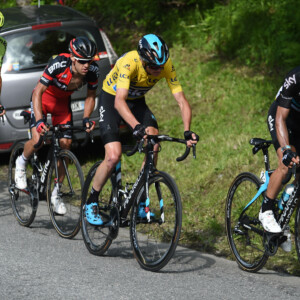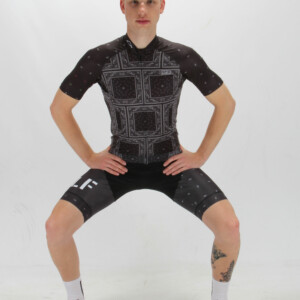Those of a certain age can probably remember a time when, depending which side of the fence you were on, shirts emblazoned with “Death to disco” or “Disco’s not dead” were not uncommon. It seems as though, with a bit of a tweak we could repurpose those slogans to become the catch cries of the opposing sides of the disc brake debate. The UCI may be still undecided on the racing future of disc brake bikes but bike manufacturers are moving ahead with the technology apace. The fact that disc brakes are no longer confined to “endurance geometry” bikes but are becoming commonplace on many brands flagship racing bikes means the momentum towards disc brakes is becoming harder to stop than a wet carbon clincher with a cantilever brake.
The Lapierre Xelius SL Disc Ultimate, apart from being a mouthful, is also an eye full. The colour scheme is striking to say the least with its neon yellow and gloss black paintwork and matching bar tape quickly putting to rest any chance of trying to sneak your disc brake bike past a vigilant commissaire busying himself measuring sock heights.

The Xelius SL Disc Ultimate is based on the standard braking Xelius SL which was piloted to an Alp d’Huez win in the 2015 Tour de France by Thibaut Pinot of team Francaise des Jeux. With a few concessions made to accommodate the obvious addition of the Shimano disc brakes the Xelius Disc still remains true to its pro team pedigree and its lightweight climbing focus. Sitting on 8kgs for an Ultegra level, disc equipped road bike the Xelius is still spritely for its spec level.
For many still sitting on the fence regarding disc brake bikes the visual aspect of the discs seems to be a common sticking point. With the Xelius however, there are plenty of other striking features to distract the eye from the discs. Aside from the blinding colour scheme, which hopefully will also act as a passive safety beacon to other road users, the frames seat tube junction is a real eye catcher. From side on the intersection of the seat tube, seat stays and top tube looks like it has been given the Salvador Dali treatment. The fluid lines of the junction of these three tubes look as though they have been pulled from molten glass. When viewed from above however the real art of the frame design becomes apparent. The seat stays leave the top tube junction forward of the seat tube then immediately split and continue past the seat tube without coming into contact with it. This gives the seat stays a greater unencumbered length with which to deal with the bumps that come with riding our wonderful roads. To that end, the Xelius does an admirable job although it’s not only the job of the seat stays to provide comfort in the saddle. The Xelius rolls on Mavic’s Ksyrium Elite wheelset in its disc version. The Ksyrium wheel has been an industry staple since its introduction in 1999. They are sturdy, stiff and reliable… and now they are better suited to wider tyres. The thing of note with the disc version of the Ksyrium wheels is that they no longer require a brake track, and visually that takes some getting used to, but it also reminds you of another big plus of using road disc brakes. On rim brakes a buckled rim a long way from home can lead to a sheepish call for a lift but with the clearance available on disc braked bike this is a non-issue. The Ksyriums are paired with Mavic’s Yksion Griplink and Powerlink tyres which, being 25mm tyres, allow for lower inflation pressures giving the Xelius a good starting point for tuning the comfort levels.

The front end of the frame does an equally capable job of making the Xelius a top flite racing machine. The addition of discs and the internal routing of the hydraulic cable through the fork doesn’t detract from the handling one iota. The steering is sharp and precise and the cable routing is tidy and unobtrusive.
The main design feature of the Xelius is without doubt the seat stay/ seat post area and how the uncoupling of these two members affects the ride. While ‘ride quality’ is an oft touted characteristic, the Xelius really delivers. However the levels to which it delivers these qualities seems dependant on more than simply the surface encountered. The weight of the rider, the distribution of that weight and the road surface all combine to make this ride a dynamic one. As someone who is currently sitting on the wrong side of 80kg’s this became very noticeable. Cruising along with weight evenly distributed the Xelius provides a firm and dependable ride on good surfaces. As the road surface deteriorates the front end feel remains plush. The only hint of the poor surface comes from an annoying buzz coming through the Shimano shifters, something which is uncharacteristic for Shimano. On big bumps, and especially with one’s weight pushing back on the Fizik Antares saddle, the big thumps are deadened to such an extent that I was occasionally checking to see if my rear tyre wasn’t underinflated. This is a pleasant feeling for what could otherwise be a tooth jarring bump, but it does provide a slight disconnection from the road feel. Given the comfort provided though, I think it’s a fair trade off.

Another thing to distract the eye from the discs is the impressive finishing kit that adorns the glossy frame of the Xelius. Zipp parts, by name alone, add to the cache of any bike. The carbon seat post and bars add a further level of comfort to the overall ride experience of the Xelius and having the bars wrapped in a two tone bar tape, colour matched to the frame theme completes the colour scheme. The groupset is Shimano’s workhorse Ultegra group in its Di2 guise. As one would expect the groupset performed faultlessly throughout the trial. The crankset is a 175mm version which is a bit longer than I’ve come to expect on a bike of this size and bucks the trend towards generally shorter cranks but some taller climbers may enjoy the extra leverage.
The hoods of Shimano’s hydraulic shifters are a bit bulkier than their rim brake counterparts, but not so much as to be a huge encumbrance. The system is powered by an internal battery and the Xelius came complete with a Di2 junction box stem mount spacer to keep the system as tidy as possible.

Obviously braking is a big selling point for this model and Sydney’s unpredictable drivers gave me plenty of opportunities to test the braking of the Xelius under a variety of circumstances. As anyone who has ridden modern disc brakes will attest predictability, efficiency and easily accessible power are the trademarks of hydraulic brakes. The ability to apply consistent braking for extended periods of time without the hands fatiguing is a big bonus for those that choose to put the Xelius to its intended use of climbing and subsequently safely descending big cols.
Summing Up:
Quality: A race proven, top shelf frame with a reliable drivetrain and good parts makes this bike a smart decision for a real all-rounder… and if only the UCI could also make a smart decision it would also make a handy race bike.

Performance: Being a pro level frame there is no issue with this bike moving you as quickly as you are willing to push it. It is a race day bike with all day comfort and performance to match its flashy looks.
Value for money: If there is a sticking point with the Xelius it may be its price point. $7,499.00 is a bit on the heavy side for an Ultegra spec bike in comparison to some other brands. But for that money you do get something different that definitely won’t go unnoticed.
Overall: If you are a big unit pushing megawatts on sprints, then be prepared for a little more rear end flex than you may be used to and a bit of a disconnection from the road. For those looking for a racy bike that provides exceptional ride quality for long hilly rides this bike is an absolute peach.

Specifications
Frame: Xelius Carbon Disc Thru Axle
Fork: Xelius Carbon Disc Thru Axle
Head Set: FSA
Stem: Zipp Service Course
Handlebars: Zipp SLC2 42cm
Saddle: Fizik Antares
Seat post: Zipp SL Speed
Shift Levers: Shimano Ultegra Di2 Hydraulic
Brakes: Shimano Ultegra Hydraulic
Front Derailleur: Shimano Ultegra Di2
Rear Derailleur: Shimano Ultegra Di2
Cassette: Shimano Ultegra 11-28
Chain: Shimano Ultegra
Crank: Shimano Ultegra 52-36 175mm
Bottom Bracket: Shimano Pressfit
Wheels: Mavic Ksyrium Elite
Tyres: Mavic Yksion Pro 25c
Weight: 8kg
Price: $7,499.00
www.advancetraders.com.au



